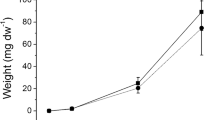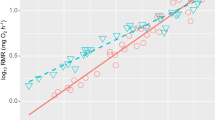Abstract
Given that triploid adult bivalves reportedly grow larger and faster than their diploid siblings, such differences should be traceable to variation in energy allocation. In one proposed mechanism, retarded gametogenesis found in triploid adults may allow them more energy for somatic growth. Another hypothesis states that triploids are more heterozygous; increased heterozygosity has been positively correlated with enhanced growth. Juvenile soft-shelled clams, Mya arenaria, were treated with cytochalasin B to induce triploidy and examined with respect to components of a balanced energy equation (C=P+R+E). The variables measured were oxygen uptake (V o 2), filtration rate (FR), dry tissue weight, shell length, shell height and shell inflation. Energy budgets were constructed and diploid and triploid groups compared. Few significant differences were found between diploid and triploid juvenile clams with respect to energy budget components. However, at seven loci assayed electrophoretically the triploid individuals were nearly twice as heterozygous as their diploid siblings. Moreover, tripoloid variances were less than diploid variances for every variable measured. Increased heterozygosity has been correlated with the decreased variance of morphological parameters. This study is believed to be the first to show decreased variance of physiological properties as well as morphological characters. Overall the data clearly indicate that energy allocation in juvenile M. arenaria is not related to ploidy.
Similar content being viewed by others
Literature cited
Adamkiewicz, L., Taub, S. R., Wall, J. R. (1984). Genetics of the clam Mercenaria mercenaria II. Size and genotype. Malacologia 25: 525–533
Aebersold, P. B., Winans, G. A., Teel, D. J., Milner, G. B., Utter, F. M. (1988). Manual for starch gel electrophoresis: A method for the detection of genetic variation. NOAA Technical Report, Sand Point, Washington (in press)
Allen, J. A. (1962). Preliminary experiments on the feeding and excretion of bivalves using Phaeodactylum labelled with 32P. J. mar. Biol. Ass. U.K. 42: 609–623
Allen, S. K. Jr., Downing, S. L. (1986). Performance of triploid Pacific oysters, Crassostrea gigas. I. Survival, growth, glycogen content and sexual maturation in yearlings. J. exp. mar. Biol. Ecol. 102: 197–208
Allen, S. K. Jr., Gagnon, P. S., Hidu, H. (1982). Induced triploidy in the soft-shell clam: cytogenetic and allozymic confirmation. J. of Hered. 73: 421–428
Allen, S. K. Jr., Hidu, H., Stanley, J. G. (1986). Abnormal gametogenesis and sex ratio in triploid soft-shell clams (Mya arenaria). Biol. Bull. mar. biol. Lab., Woods Hole 170: 198–210
Bayne, B. L. (ed.) (1976). Marine mussels: their ecology and physiology. Cambridge University Press, New York
Bayne, B. L., Newell, R. C. (1983). Physiological energetics of marine molluscs. In: Saleuddin, A. S. M., Wilbur, K. M. (eds.) The Mollusca Vol. 4. Academic Press, New York, p. 407–515
Beaumont, A. R., Beveridge, C. M., Budd, M. D. (1983). Selection and heterozygosity within single families of the mussel Mytilus edulis (L.). Mar. Biol. Lett. 4: 151–161
Beaumont, A. R., Gosling, E. M., Beveridge, C. M., Budd, M. D., Burnell, G. M. (1985). Studies on heterozygosity and size in the scallop Pecten maximus. In: Gibbs, P. E. (ed.) Proc. 19th Eur. Mar. Biol. Symp. Cambridge University Press, New York, p. 443–445
Berry, P. F., Schleyer, M. H. (1983). The brown mussel Perna perna on the Natal coast, South Africa: utilization of available food and energy budget. Mar. Ecol. Prog. Ser. 13: 201–210
Boyer, S. H., Fainer, D. C., Watson-Williams, E. J. (1963). lactate dehydrogenase variant from human blood: Evidence for molecular subunits. Science, N.Y. 141: 642–643
Chaiton, J. A., Allen, S. K. Jr. (1985). Early detection of triploidy in the larvae of the Pacific oyster, Crassostrea gigas, by flow cytometry. Aquaculture 48: 35–43
Clayton, J. W., Tretiak, D. N. (1972). Amine-citrate buffers for pH control in starch gel electrophoresis. J. Fish. Res. Bd. Can. 29: 1169–1173
Conover, R. J. (1966). Assimilation of organic matter by zooplankton. Limnol. and Oceanogr. 11: 338–354
Conover, R. J. (1978). Transformation of organic matter. In: Kinne, O. (ed.) Marine Ecology. Vol. IV. Wiley-Interscience, New York, p. 221–499
Conrad, M. (1983). Adaptability: The significance of variability from molecule to ecosystem. Plenum Press, New York
Coughlan, J. (1969). The estimation of filtering rate from the clearance of suspensions. Mar. Biol. 2: 356–358
Crisp, D. J. (1971). Energy flow measurements. In: Holmes, N. A., McIntyre, A. D. (eds.) Methods for the study of marine benthos. IBP Handbook No. 16. Blackwell Scientific Publications, Oxford, p. 197–279
Dame, R. F. (1972). The ecological energies of growth, respiration and assimilation in the intertidal American oyster Crassostrea virginica. Mar. Biol. 17: 243–250
Defendi, V., Stoker, M. G. P. (1973). General polyploidy produced by cytochalasin B. Nature, Lond. 242: 24–26
Eanes, W. F. (1978). Morphological variance and enzyme heterozygosity in the monarch butterfly. Nature, Lond. 276: 263–264
Ehinger, R. E. (1978). Seasonal energy balance of the sea scallop, Placopecten magellanicus, from Narragansett Bay. M.S. thesis, University of Rhode Island
Epifanio, C. E., Ewart, J. (1978). Maximum ration of four algal diets for the oyster Crassostrea virginica Gmelin. Aquaculture 11: 13–29
Foltz, D. W., Zouros, E. (1984). Enzyme heterozygosity in the scallop Placopecten magellanicus (Gmelin) in relation to age and size. Mar. Biol. Lett. 5: 255–263
Fujio, Y. (1982). A correlation of heterozygosity with growth rate in the Pacific oyster, Crassostrea gigas. Tohuku J. agr. Res. 33: 66–75
Gabbott, P. A. (1975). Storage cycles in marine bivalve molluscs: a hypothesis concerning the relationship between glycogen metabolism and gametogenesis. In: Barnes, H. (ed.) Proc. Ninth Euro. mar. biol. Symp. Cambridge University Press, New York, p. 191–211
Gaffney, P. M., Scott, T. M. (1984). Genetic heterozygosity and production traits in natural and hatchery populations of bivalves. Aquaculture 42: 289–302
Garton, D. W., Koehn, R. K., Scott, T. M. (1984). Multiple locus heterozygosity and the physiological energetics of growth in the coot clam, Mulinia lateralis, from a natural population. Genetics 108: 445–455
Gerdes, D. (1983). The Pacific oyster Crassostrea gigas part I. Feeding behavior of larvae and adults. Aquaculture 31: 195–219
Goldberg, R. (1985). Growth and energetics of the surf clam, Spisula solidissima, (Dillwyn) at different algal concentrations. M.S. thesis, Southern Connecticut State University
Green, R. H., Singh, S. M., Hicks, B., McCuaig, J. M. (1983). An arctic intertidal population of Macoma balthica (Mollusca, Pelecypoda): genotypic and phenotypic components of population structure. Can. J. Fish. Aquat. Sci. 40: 1360–1371
Griffiths, C. L., King, J. A. (1979). Energy expended on growth and gonad output in the ribbed mussel Aulacomya ater. Mar. Biol. 53: 217–222
Hamburger, K., Mohlenberg, F., Randlov, A., Riisgard, H. U. (1983). Size, oxygen consumption and growth in the mussel Mytilus edulis. Mar. Biol. 75: 303–306
Hughes, R. N. (1970). An energy budget for a tidal-flat population of the bivalve Scrobicularia plana (Da Costa). J. Anim. Ecol. 39: 357–379
Jorgensen, C. B. (1976). Growth efficiencies and factors controlling size in some mytilid bivalves, especially Mytilus edulis L.: Review and interpretation. Ophelia 15: 175–192
Koehn, R. K., Gaffney, P. M. (1984). Genetic heterozygosity and growth rate in Mytilus edulis. Mar. Biol. 82: 1–7
Koehn, R. K., Shumway, S. E. (1982). A genetic/physiological explanation for differential growth rate among individuals of the American oyster, Crassostrea virginica (Gmelin). Mar. Biol. Lett. 3: 35–42
Langefoss, C. M., Maurer, D. (1975). Energy partitioning in the American oyster, Crassostrea virginica (Gmelin). Proc. nat. Shellfish Assoc. 65: 20–25
Laughlin, R. B., Wofford, H. W., Neff, J. M. (1979). Simple potentiometric method for the rapid determination of respiration rates of small aquatic organisms. Aquaculture 16: 77–82
Lerner, I. M. (1954). Genetic homeostasis. Oliver and Boyd, Edinburgh
Longo, F. J. (1972). The effects of cytochalasin B on the events of fertilization in the surf clam. Polar body formation. J. exp. Zool. 182: 321–344
McAndrew, B. J., Ward, R. D., Beardmore, J. A. (1982). Lack of relationship between morphological variance and enzyme heterozygosity in the plaice, Pleuronectes platessa. Heredity 48: 177–125
Mitton, J. B. (1978). Relationship between heterozygosity for enzyme loci and variation of morphological characters in natural populations. Nature, Lond. 273: 661–662
Mitton, J. B., Grant, M. C. (1984). Associations among protein heterozygosity, growth rate, and development homeostasis. Annu. Rev. Ecol. Syst. 15: 479–499
Mitton, J. B., Koehn, R. K. (1985). Shell shape variation in the blue mussel, Mytilus edulis L., and its association with enzyme heterozygosity. J. exp. mar. Biol. Ecol. 90: 73–80
Newell, R. C. (1979). Biology of intertidal animals. Marine Ecological Surveys, Faversham, Kent
Newell, R. I. E. (1983). Molluscan bioenergetics — a synopsis. In: Pruder, G. D., Langdon, C., Conklin, D. (eds.) Proc. of the Second International Conf. on Aquaculture and Nutrition: Biochemical and Physiological Approaches to Shellfish Nutrition. Louisiana State University, Louisiana, p. 252–271
Nielsen, M. V. (1985). Increase in shell length as a measure of production and ingestion of Mytilus edulis L. J. exp. mar. Biol. Ecol. 88: 101–108
Rodhouse, P. G., Gaffney, P. M. (1984). Effect of heterozygosity on metabolism during starvation in the American oyster, Crassostrea virginica. Mar. Biol. 80: 179–187
Rodhouse, P. G., McDonald, J. H., Newell, R. I. E., Koehn, R. K. (1986). Gamete production, somatic growth and multiple-locus enzyme heterozygosity in Mytilus edulis. Mar. Biol. 90: 209–214
SAS User's Guide. Statistics. SAS Institute Inc., Cary, North Carolina, p. 433–506
Shumway, S. E., Newell, R. C. (1984). Energy resource allocation in Mulinia lateralis (Say), an opportunistic bivalve from shallow water sediments. Ophelia 23: 101–118
Singh, S. M., Zouros, E. (1978). Genetic variation associated with growth rate in the American oyster (Crassostrea virginica). Evolution 32 (2): 342–353
Stanley, J. G., Allen, S. K. Jr., Hidu, H. (1981). Polyploidy induced in the American oyster, Crassostrea virginica with cytochalasin B. Aquaculture 23: 1–10
Stanley, J. G., Hidu, H., Allen, S. K. Jr. (1984). Growth of American oysters increased by polyploidy induced by blocking Meiosis I but not Meiosis II. Aquaculture 37: 147–155
Tabarini, C. L. (1984). Induced triploidy in the bay scallop, Argopecten irradians, and its effect on growth and gametogenesis. Aquaculture 42: 151–160
Thayer, G. W., Schaaf, W. E., Angelovic, J. W., LaCroix, M. W. (1973). Caloric measurements of some estuarine organisms. Fish. Bull. U.S. 71: 289–296
Vahl, O. (1973). Pumping and oxygen consumption rates of Mytilus edulis L. of different sizes. Ophelia 12: 45–52
Wilkins, N. P. (1978). Length-correlated changes in heterozygosity at an enzyme locus in the scallop (Pecten maximus L.). Anim. Blood Grps. biochem. Genet. 9: 69–77
Wolf, U., Engel, W., Faust, J. (1970). The mechanism of diploidization in vertebrate evolution: Coexistence of tetrasomic and disomic gene loci for the isocitrate dehydrogenases in trout (Salmo irideus). Humangenetik 9: 150–156
Zar, J. H. (1974). Biostatistical Analysis. Prentice-Hall, Inc. New Jersey
Zouros, E., Singh, S. M., Miles, H. E. (1980). Growth rate in oysters: an overdominant phenotype and its possible explanations. Evolution 34 (5): 856–858
Author information
Authors and Affiliations
Additional information
Communicated by J. P. Grassle, Woods Hole
Rights and permissions
About this article
Cite this article
Mason, K.M., Shumway, S.E., Allen, S.K. et al. Induced triploidy in the soft-shelled clam Mya arenaria: energetic implications. Marine Biology 98, 519–528 (1988). https://doi.org/10.1007/BF00391543
Accepted:
Issue Date:
DOI: https://doi.org/10.1007/BF00391543




